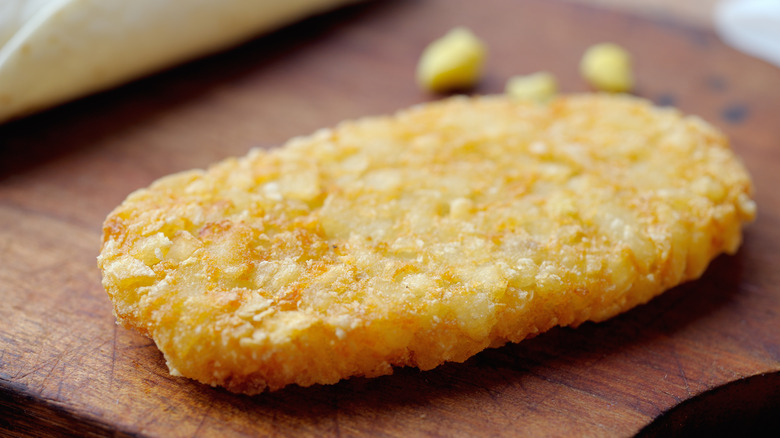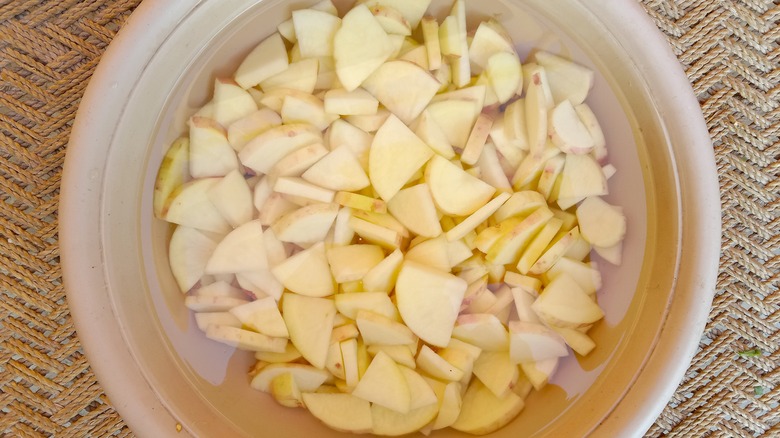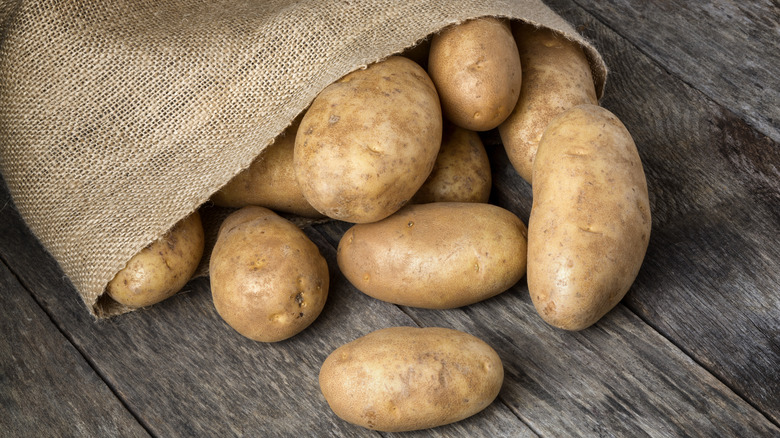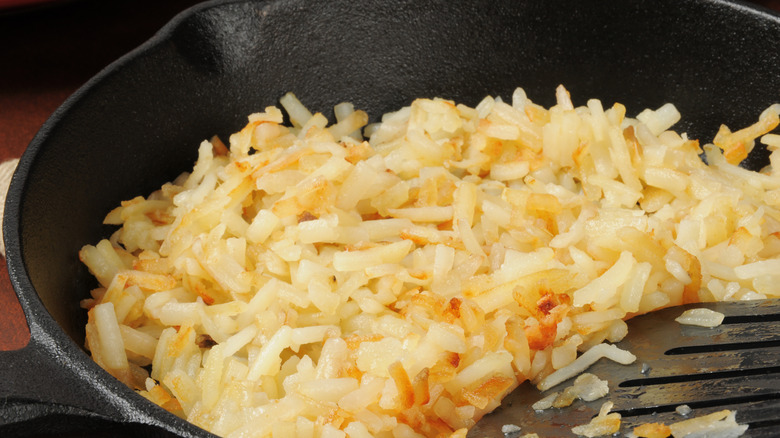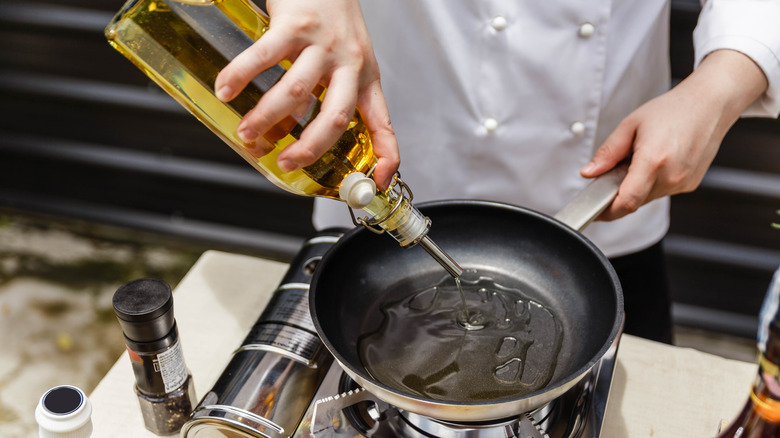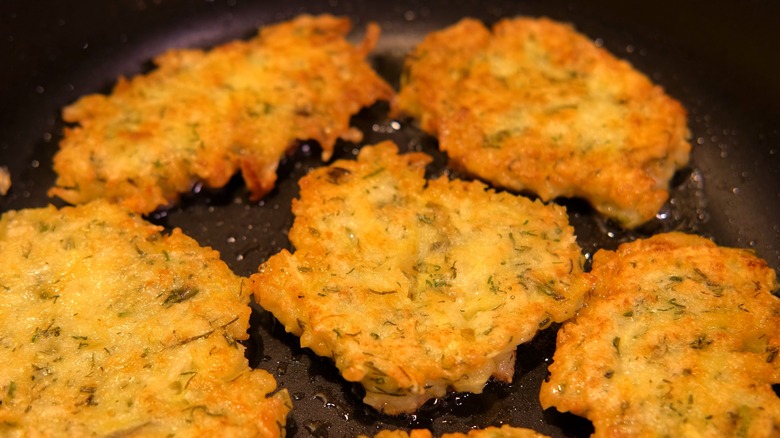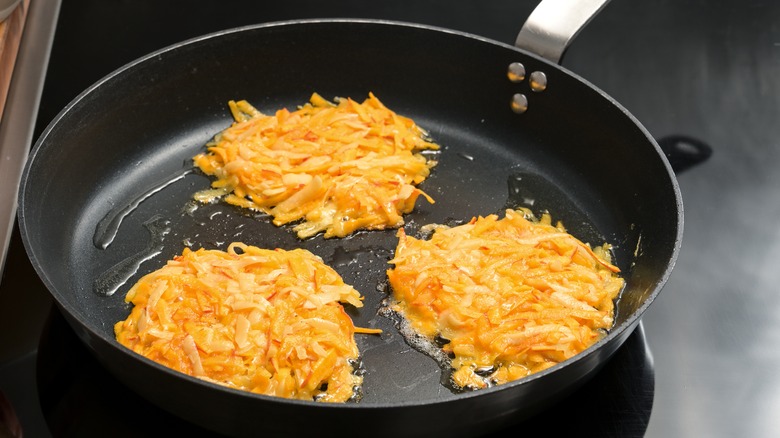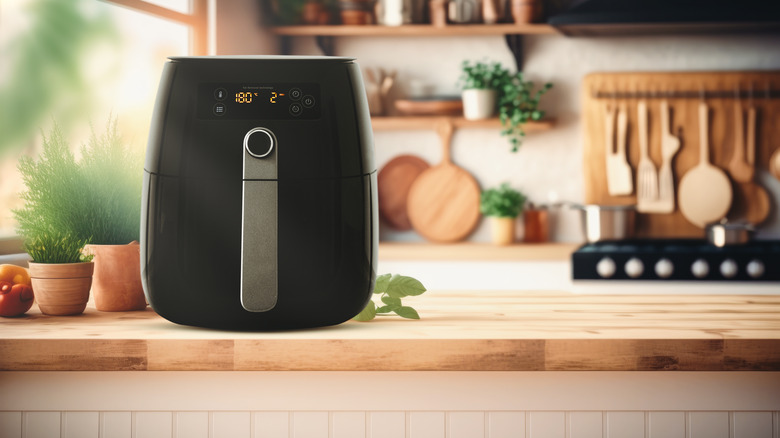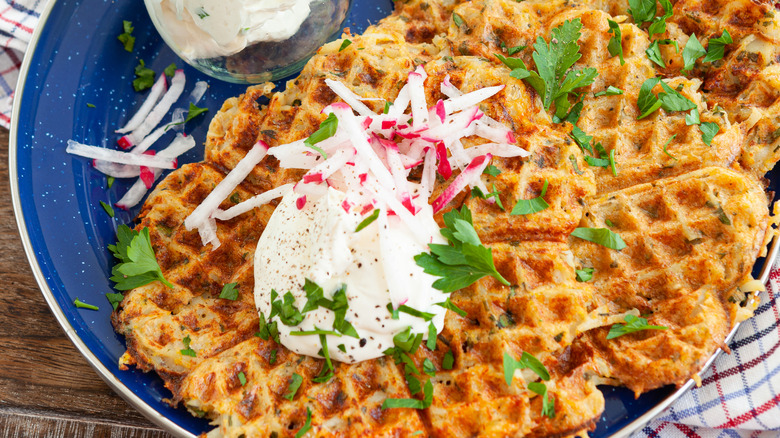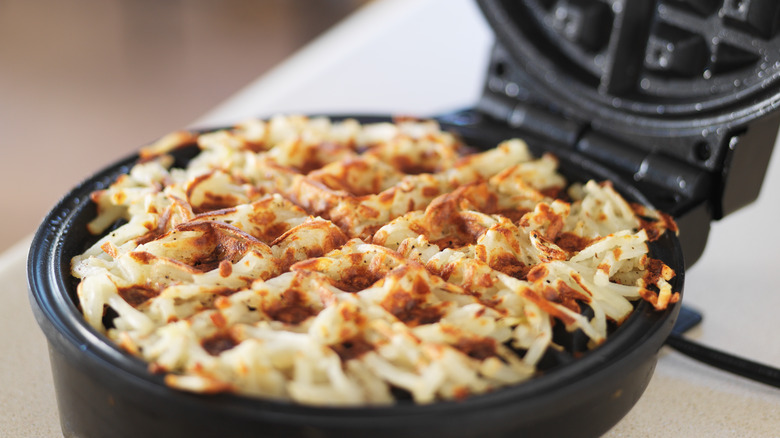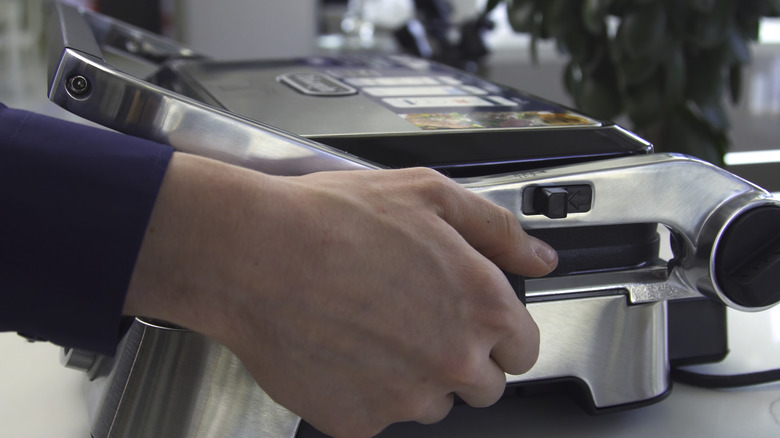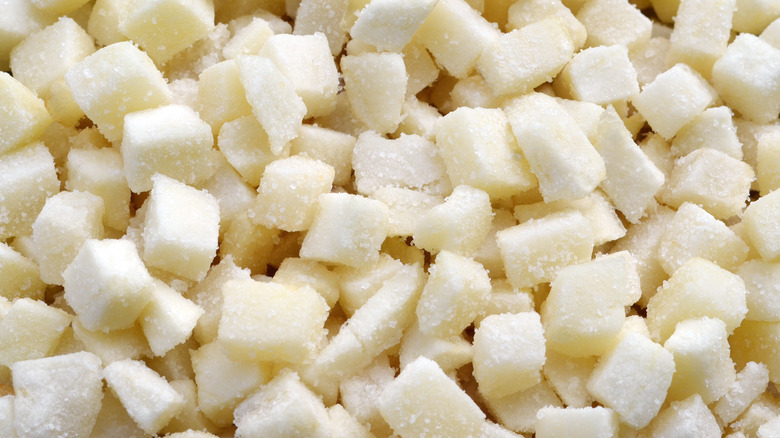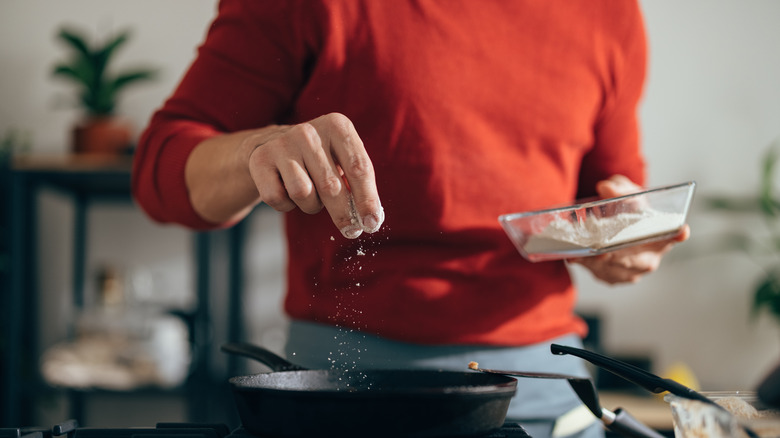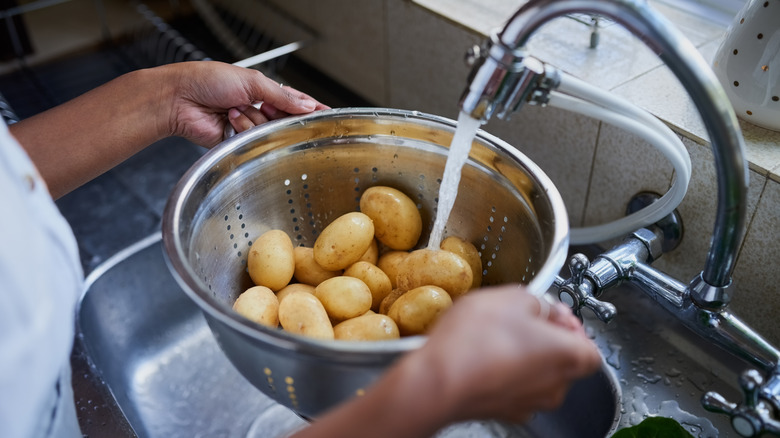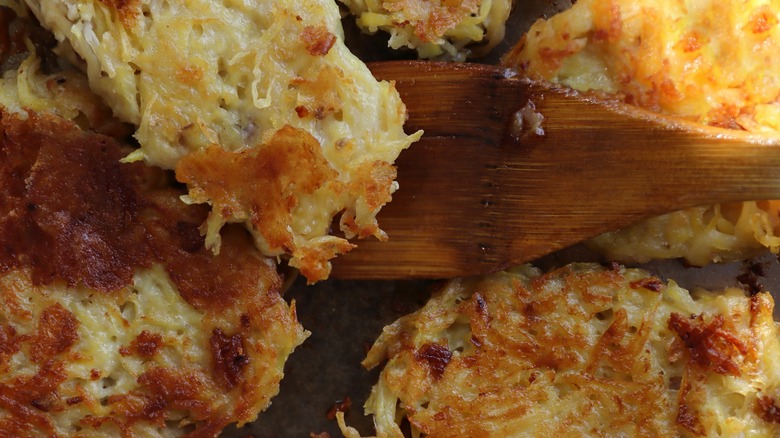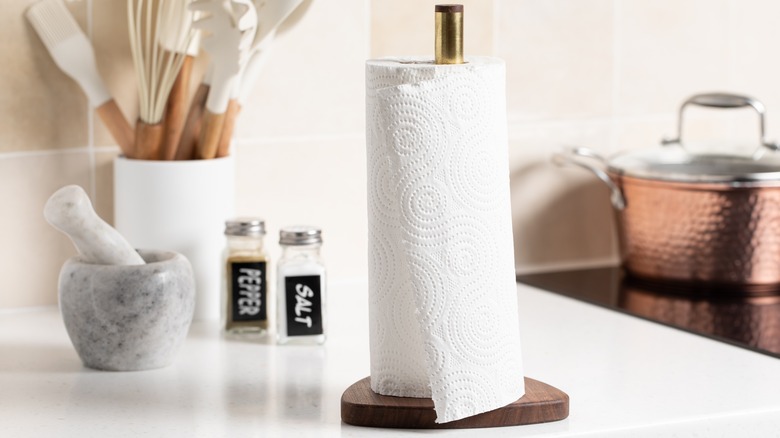15 Tips For Perfectly Cooked Crispy Hash Browns
We love potatoes at any time of day, but breakfast is where they truly shine. But our favorite way to eat spuds in the morning is undoubtedly in hash brown form served with a side of breakfast meat and eggs. These potatoes are typically seasoned with herbs and spices and come in one of four styles: shredded, patties (fast-food style), country-style (cubed), and O'Brien (shreds with onions and peppers). It is believed that the origin of hash browns is connected to the French word "hacher," meaning to chop. As a result, there are many people who believe the country-style "hash" doesn't deserve the hash brown title and should be relegated to the home fries territory instead.
Regardless of how you feel about what constitutes a proper hash brown, we can all agree that the best varieties are deliciously crunchy on the outside. Here are some of our best tips for ensuring your hash browns come out crisp and the perfect companion to your other breakfast favorites.
Avoid soaking the potatoes
Potatoes are notoriously starchy vegetables, and the rinsing process does nothing besides wash away this important quality. Peeling, grating, and rinsing the potatoes before making the recipe will cause the hash to struggle to hold together in the pan. Moreover, the starch helps boost the crispiness of the potato, so a hash devoid of it will just turn to painfully soggy mush on a plate.
Instead of removing the starch from the potato, you should focus on mitigating moisture. This will keep the starch molecules intact and ensure your hash crisps up well. The easiest way to do this is to wring the excess water out of the potatoes before plopping them into the pan (or whatever gadget you opt to cook the recipe in). This process will need to happen several times and should be done with a thin tea towel for the most advantageous results.
Start with the right type of potato
With the sheer number of potato varieties out there, how do you decide which will be the best one for cooking? If you've been opting for anything other than a starchy spud like a russet, you've been making hash browns wrong all this time. Russets are ideal for baking and frying because they have the highest starch content. This will help the spuds stick together as they cook and create the perfect texture for your recipe. If you don't have access to russet potatoes, Yukon Golds are a clear close second. Other starchy potato varieties include the sweet potato, which can be made into a sweet hash brown by adding a touch of cinnamon or nutmeg.
The types of potatoes you'll want to avoid for your hash browns are anything waxy. This includes the classic red bliss, which can be found in potato salads, and any sort of small fingerling variety.
Stick to a cast iron skillet for stovetop cooking
The stovetop is the go-to cooking method for many hash brown enthusiasts. Not only are these potatoes easy to bring together and cook on a small skillet, but they also allows you to keep a wary eye on the hash as it cooks. After all, we want crispy — not burnt.
Our favorite type of pan to fry up hash browns in is a cast iron skillet. This pre-seasoned pan not only conducts heat well (and holds it for the duration of the cooking time), but it also has a non-stick coating that will prevent pesky pieces of potato from sticking to its sides. To keep hash browns from sticking to your fry pan, ensure it's adequately preheated before plopping in your spuds. If you plop a couple of droplets of water into the skillet, it should ball up rather than vaporize.
Bring on the oil but skip the butter
We're not cooking for health here, so we recommend bringing on the oil, particularly anything neutrally tasting that has a high smoke point. Hash brown enthusiasts will often stick to olive oil (not the grassy-tasting extra virgin variety), avocado oil, or a basic seed oil like sunflower or rapeseed. Spread enough oil on the bottom of your pan to prevent the hash from sticking — and make sure that your temperatures are high enough.
Although you might also reach for the butter for making your hash browns, we recommend refraining from adding pads to your recipe. Since butter contains a small amount of water and has a low smoke point, it tends to let off some bitter flavor notes if you cook it too high on the stovetop. If you are insistent on a buttery taste, try opting for clarified butter instead since it can reach higher temperatures without smoking.
Don't swamp your hash browns in oil
You need to be careful how much oil you use to cook hash browns because flooding your pan won't cause your spuds to crisp up. Instead, it will just make them soggy. Plus, the oily flavor won't cook off, so you'll be left with a greasy breakfast side that sticks to your ribs — and not in a good way.
The key to mastering hash browns is to add a thin oil coating to the entire pan and stick to a wide-bottomed skillet for easy flipping and to ensure your patties don't touch. Making sure your pan is preheated before adding your spuds will also decrease the residual oil flavor left on the potatoes. If you want the McDonald's hash brown level of crisp, you can also shape your patties and fry them in an inch of hot oil straight from frozen. The oil temperature is critical here since frying too low will just leave you with greasy potato pucks.
Don't move the potatoes around once they hit the oil
When we're cooking anything in the kitchen, we often find ourselves picking at whatever food is on the stovetop. However, the tip you should follow for crispy, evenly cooked hash browns is to leave your patties alone on the stove. After you've shredded, rinsed, and dried your hash browns, place them gently into the hot oil on the pan and walk away. If you stir and toss your hash browns around, you won't give them the opportunity to develop any color or crisp up. Stirring and sautéing your spuds will only leave them limp, which is not ideal for any breakfast lover.
To be clear, we're not advocating for walking away from the stove entirely since it can cause a fire hazard. Just try to tuck your spatula away in a cabinet until your kitchen timer goes off to flip the patties over.
If you're going with an air fryer, don't neglect preheating
If you are preparing hash browns as a side dish for eggs or waffles, you're going to want to pick a relatively hands-off cooking method. For many folks, that option is an air fryer. Preheating your air fryer is the one step you should never skip when air frying frozen hash browns. Most air fryers will give you a preheating option and a straight "air fry" setting. Other machines will automatically preheat before reaching the selected temperature, so it's best to take a glance through your appliance manual before pulling the hash out of the freezer. And although it might take a little extra time to bring your air fryer up to the proper temperature, you will be rewarded with the perfect level of crispiness on your potatoes.
Scientifically speaking, it's best to pop your frozen food into a preheated oven (or air fryer) because it has a hotter temperature. This increases the rate of moisture evaporating from the frozen food, thus rendering it crispy rather than soggy.
Pop them in a waffle iron instead of the oven
If you're going for the novelty aspect of fun-shaped hash browns, you will want to turn to your waffle maker. It's Ina Garten's favorite kitchen tool for the crispiest possible hash browns because the iron gets into every nook and cranny of the hash mixture and transports it to crispy perfection. The Barefoot Contessa always uses freshly shredded russet potatoes for her recipe, but we're living by her mantra of "store-bought is fine," so using a frozen shredded hash is always an option for a cheap, easy breakfast.
The trick to making hash brown waffles is to always combine the hash mixture with a few eggs and flour to help the hash bind together. And unlike regular waffles, you won't have to worry about the filling shrinking when it hits the iron. If you cook your hash on medium-high, you can expect to have a giant hash brown waffle waiting for you in less than 10 minutes. And if you open the lid to find the potatoes aren't crisp enough for your liking, push the lid back down and hold it shut for a few extra minutes.
Spread the potatoes to the edge of the waffle maker
Placing the hash in the waffle maker is just the first step to getting crispy hash browns. The best trick for super crispy hash brown waffles is to always push the potato shreds to the edges of the iron and distribute them evenly. NBA star Shaquille O'Neal uses this method when he makes the waffle hash browns from his "Shaq's Family Style" cookbook, which he tops with bacon, scallions, and shredded cheese.
When you're cooking your hash browns on the iron, you'll also always want to start with a hot, greased pan. Although many of these products are marketed as being non-stick, any sort of damage to the pan will quickly cause it to stick and burn rather than cook up crisp, not to mention it's also a pain to clean when there are pieces of potato stuck to it.
Stick with a panini press for hands-off hash browns
If you're fortunate enough to have a panini press in your kitchen, you will want to use it for making hash browns. This kitchen appliance will ensure that both sides of the hash brown cook evenly and simultaneously, reducing the time you'll have to spend standing over the stove watching it cook.
To use this method, you'll need to add ½ cup of frozen shredded potatoes to the center of your press. It's essential to put it away from the edges of the press because this could disrupt the seal and result in spots of undercooked potatoes. Press down until the potatoes are partially cooked before adding another ½ cup of hash to the press. From there, you can sandwich the lid of the press down and cook the potatoes for another six to seven minutes before removing it from the hot surface.
Thaw frozen potatoes before cooking them
While frozen hash takes some of the work out of peeling and shredding your potatoes, it isn't an entirely hands-off process. Thawing will help speed up the cooking time and ensure that your hash doesn't have any residual frost lurking inside of it. Besides not wanting to bite into an icy chunk (yuck!), thawing out your frozen potato pieces also allows you to squeeze out the moisture before it hits the pan, which will give you a crispier end product.
There are numerous ways to defrost your potato products safely and effectively. You can nuke them in the microwave, checking on them every 30 seconds, or plop them in the refrigerator about a day before you plan to cook with them. It is not recommended to leave your spuds on the counter to defrost because this can mean that your potatoes get dangerously close to the temperature danger zone and even make you sick.
Avoid salting the potatoes before flipping
Seasoning is critical to making a delicious batch of hash browns. However, it can also be the reason you end up with soggy hash browns. You should only salt the potatoes right before you flip them in the pan, not when you're shaping them or putting them into the oil. This is because salting the spuds will cause them to release moisture, which is not ideal for a perfectly crisp hash brown.
It is perfectly acceptable to add other non-salt seasonings to the hash browns when you're shaping them. One of our favorite seasoning combos for hash browns brings together smoked paprika, garlic powder, and onion powder. Freshly cracked black pepper is also a staple for hash-browns. Alternatively, you can also use smoked or seasoned salt or step it up with a bit of Montreal steak seasoning (don't knock it until you try it) once your potatoes are flipped.
Par-cook the potatoes to reduce the water content
Most people stick to cooking their hash browns straight from raw. But the secret to making perfectly crisp hash browns every time is to cook the potatoes in the microwave after you've squeezed as much moisture out as possible. A two-minute spin in the microwave removes some of the leftover moisture and shortens the cooking time when your spuds hit the oil. Potatoes that have been par-cooked will only need to be cooked in the skillet for about two minutes on each side.
This hack will get even crispier breakfast potatoes because it concentrates the starch in the spuds and reduces the water content. Besides microwaving your shredded potatoes, you can also par-boil the potatoes before grating them, but handling a hot potato is a little more precarious than a plate or bowl of shreds. But, a par-cooked potato is a par-cooked potato.
Resist the urge to flip stovetop hash browns too early
Making hash browns is an act of love — and patience. One of the reasons why your hash browns are coming out soggy is because you accidentally (or not so accidentally) flipped them over prematurely. You'll know your hash browns are ready to flip when the underside is hardened and starts to take on a beautiful golden-brown hue.
Hash browns that are made thinner will cook much faster than ones that are too thick, so you can also size your spuds just right for the perfect crisp exterior. If you're baking hash browns in the oven, you won't have to toss the potatoes halfway through the cooking process. It will take between 35 and 40 minutes for a perfectly crisp texture, but you can use this time to cook up some bacon (using the same oven) and get to work on your pancake batter.
Use a paper towel to drain the excess oil
It's important that you don't give up the quest for perfectly crispy potatoes until you have your crunchy spuds on a plate. Once your hash browns are done cooking, you're going to want to put them on a paper towel to soak up any of the excess oil. The paper towel has a very fine texture that is aimed at drawing in and holding moisture. While a wire rack will give you a better airflow underneath your spuds, it won't allow much oil to drip out.
If you're looking to cut down on waste in your kitchen, you can also use leftover brown grocery bags to soak up excess oil. While some people may suggest using cardboard egg cartons for the same purpose, it's important to note that the cartons can carry Salmonella which can then be transferred to your ready-to-eat hash browns.
